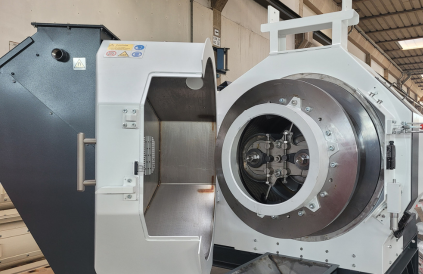Pellet Mill Die Starting
Starting a pellet mill die refers to initiating the pellet production process in a pellet mill machine.
There are some general steps regarding the dies that must be more accurate for a better production process. Also, there are cases where certain criteria are fundamental for the best functioning of the pellet press.
- When starting a new die, proceed slowly, do not increase feed rate until the ammeter is reasonably steady. The mill should always be started with a relatively low feed.
- If the die is "plugged" and feed burned into the holes, it may be necessary to drill or punch out the pellets before the die can be used again.
- The feed and steam can be increased as rapidly as indicated by the ammeter. There is no substitute for experience in operating a pellet mill. An experienced operator can get his pellet mill up to maximum capacity in a matter of a few minutes and with very little effort.
- Do not crowd a new die. Give it a chance to warm up and wear in before trying to obtain full capacity, but at the same time push the die to full capacity as quickly as it will accept material.
- Your pellet mill die has been carefully machined and highly polished at the factory. However, actual use with most feeds will produce an even higher polish than is possible in the manufacturing process. For this reason, maximum production will usually not be obtained from a die until it has had several hours of operation.
What to do after a pellet plant shut-down
- When starting a pellet mill after a shut-down, one should not attempt to immediately run the pellet mill at the same setting at which it was shut down. As the pellets cool in the die, they become tightly bonded in the holes. Extreme pressure is required to once again get the material in motion through the die.

Dies with 10 mm holes
If a die with holes 10mm or larger is being started, use an excess of steam. It is easier to fill the holes with moist mach. The first pellets will be too soft and mushy. This is corrected by slowly increasing the amount of dry material until the pellets become firm.
Do not rush this operation. The die must have time to warm up and if the material is dried down too quickly, the holes in the die may become plugged. After the die is warmed and the pellets are firm, increase the output of the pellets.
Dies with 12 mm or larger holes
With some materials, when starting a large hole die (12 or larger) it is sometimes difficult, even with extremely wet mash, to fill the die and start pelleting. In this case, time and effort can be saved by wrapping the outside of the die with several turns of gummed tape, or even a layer of heavy paper bound with wire. This will cause the holes to immediately be filled with compressed material.
As soon as the pellets start forming, the paper will be torn away and may be re-covered at the pellet discharge. In the event that wire is used, it will be necessary to stop the machine to remove the wire. Again, after the die is harmed and the pellets are firm, increase the output of pellets in the same manner as described above for small hole dies.
The above outlined procedure will guide the operator through his first start up and as he becomes familiar with the pellet mill, he will discover various tricks of the trade. These will vary with conditions of operation, type of feed being handled and type of pellets demanded by the customer. A little experimentation will assist him in quickly arriving at a high hourly output of top quality pellets.
Only one bit of caution is needed: do not overload the pellet mill as a substitute for the correct die or proper conditioning of the feed.